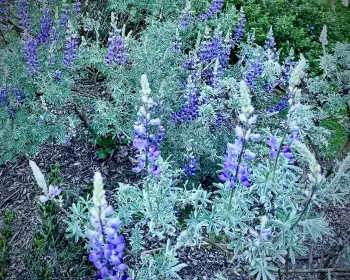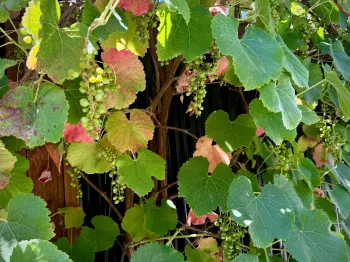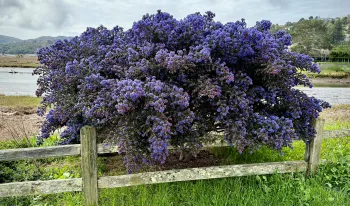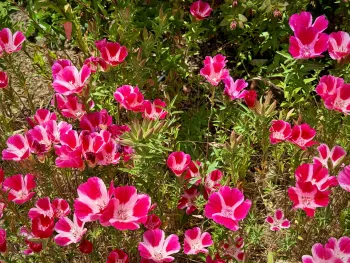
Native plants are often known for grand springtime displays followed by dismal summer and fall foliage. But that isn’t true for all native plants. A little research, careful planning, and conscientious planting can have your garden blooming with colorful, flowering, summer dry, winter wet native plants all through the year.
Even though some native plants might not look great in fall, it’s the best time to take home these climate attuned plants. You can settle them into the ground before the winter rains, which they expect, and they’ll put down roots before the summer dry season begins. Having said that, you should water these newbies regularly for the first year or two – until they’re well established. Use a water tester to know when and how much to water – probably once or twice a week the first year. When they’ve doubled in size, it’s likely they’re established enough to cut back on watering. Keep testing to be sure. There’s an adage some native plant growers use to describe how quickly these plants grow during their first three years: Sleep, creep, leap.

So, which native plants to buy? Here are some favorites:
Fall: Red leaves; pink, purple, red/orange, white flowers. Vitis ‘Roger’s Red’ (Roger’s Red Grape) is a fast-growing deciduous vine whose leaves turn a stunning red in the fall. Low-growing Epilobium canum (California Fuchsia) begins flashing red-orange flowers on gray-green foliage in summer and continues through fall. Corethrogyne filaginifolia (California Sandasters) carry their pink, purple, or white flowers from summer into winter.
Winter: Red berries; white, pink, or yellow flowers. In winter, white or pink flowers cover Arctostaphylos (Manzanita) species, whether ground cover, shrub, or tree; and pollinators welcome the food source. Heteromeles arbutifolia (Toyon), a tall shrub/tree, produces red berries around Christmas and adapts well to non-native gardens. Ribes species (Currants and Gooseberries), which range from low and medium-sized shrubs to tree sizes, produce cascades of small pink or yellow flowers loved by hummingbirds.

Spring: Blue, white, pink, lilac, lavender, yellow flowers. The intense blue-flowered Ceanothus (California Lilac) are springtime stars. Like Manzanita, various species can be ground covers, shrubs, or grow very tall. Some bloom in late winter; others flower well into summer. In spring, our California native Clematis displays large white flowers and native Heucheras wave delicate pink/white flowers. By contrast, Verbena lilacina ‘De La Mina’ and Erigeron glaucus (Seaside Daisies) have lavender flowers. Lupinus (Lupine) and Iris douglasiana (Douglas Iris) have lavender, white, or yellow flowers. Lupines’ foliage can be silvery or green, and they can be small or tall.

Summer: Red, lavender, blue, yellow, pink, white flowers. Consider Eriogonum (Buckwheat) with white, pink, yellow, or red flowers; Clarkia amoena’s (Farewell to Spring) hot pink flowers; and Achillea millefolium’s (Yarrow) white flowers. Of these, Buckwheat comes in the largest range of sizes – from ground cover to giant shrub. Clarkia is a tall annual flower that re-seeds. Two other reliable favorites for summer flowers are native Penstemons (red, lavender, or blue Beardtongues) and Salvia (Sages with red, lavender, blue, or white flowers.) Choose from hundreds of Penstemon and Sage species for specific color and sun requirements.
You can successfully blend native plants into a non-native garden if you pay attention to water and sun requirements. You could create islands of very low water or low water plants, mix native plants with low-water Mediterranean plants, or organize your drip irrigation system to give some plants more water than others, being very careful that the native plants don’t get too much water.
To research plants, find descriptions and requirements, and see color photos, use the California Native Plant Society website: calscape.org. Or, take a few minutes to watch a short video filmed by UC Marin Master Gardeners in a local native plant garden that includes many of the above-mentioned plants. The video is on YouTube: Color Your Garden with CA Native Plants - All Year Round!
Happy Gardening!
By Barbara Robertson, October 4, 2025

